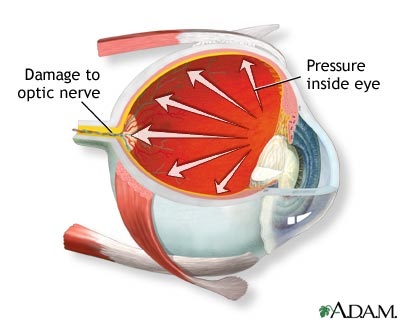Eyekipedia: Glaucoma
|
Glaucoma is a leading cause of blindness. Over 2.2 million Americans have already been diagnosed with glaucoma, and 100,000 new cases are diagnosed each year. Worldwide, there are an estimated 65 million cases of glaucoma. About 2% of people between the ages of 40 and 50, and 8% of those over 70, have elevated intraocular pressure in one or both eyes.
Glaucoma is often called the "silent thief of sight" because there are no early warning signs. It's estimated that more than two million people may have the disease and not know it.
|
There are 120,000 people in the United States who are blind as a result of glaucoma, which accounts for 9-12% of all cases of blindness. It is the second leading cause of permanent vision loss and the leading cause of preventable blindness. Open angle glaucoma accounts for 19% of blindness in African Americans and 6% in Caucasians.
Glaucoma is six to eight times more common in African Americans than Caucasians, and they are more likely to become blind from it.
Glaucoma is six to eight times more common in African Americans than Caucasians, and they are more likely to become blind from it.
Glaucoma is caused by increased intraocular pressure (IOP) resulting either from a malformation or malfunction of the eye's drainage structure. The eye constantly produces aqueous, the clear fluid that fills the anterior chamber, which is the space between the cornea and iris. The aqueous filters out of the anterior chamber through a complex drainage system. Left untreated, an elevated IOP causes irreversible damage to the optic nerve and retinal fibers resulting in a progressive, permanent loss of vision. However, early detection and treatment can slow, or even halt the progression of the disease.
Types
There are many different types of glaucoma but the two major types are primary open-angle and angle- closure.
Primary open-angle glaucoma accounts for 60-70% of glaucoma cases in the United States. In open-angle glaucoma, the aqueous humor is unable to drain out of the eye, damaging the optic nerve. Most people do not experience symptoms until their vision is compromised and extensive damage to the optic nerve has been done. Peripheral vision is affected before central vision.
Angle-closure glaucoma, also known as narrow-angle glaucoma, accounts for fewer than 10% of cases. In most cases, the iris blocks the trabecular meshwork, preventing drainage of aqueous humor and raising intraocular pressure. If the drainage channel is completely blocked, IOP rises suddenly, causing acute angle-closure glaucoma. Symptoms may be severe and include extreme eye pain, nausea, blurred vision, and halos around lights. Acute angle-closure glaucoma is a medical emergency that must be treated by an ophthalmologist immediately. Permanent vision loss can occur within days.
Symptoms
Detection and prevention are only possible with routine eye examinations. However, certain types of glaucoma, such as angle closure and congenital, do cause symptoms. Among these are a sudden decrease in vision, severe eye pain, headaches and sensitivity to light, sudden increase in IOP and swollen or clouded cornea.
Because glaucoma does not cause symptoms in most cases, those who are 40 or older should have an annual examination including a measurement of the intraocular pressure.
Treatment
Most patients with glaucoma require only medication to control the eye pressure. Sometimes, several medications that complement each other are necessary to reduce the pressure adequately.
Surgery is indicated when medical treatment fails to lower the pressure satisfactorily. There are several types of procedures. Some involve lasers and can be done in the office others must be performed in the operating room. The objective of any glaucoma operation is to allow fluid to drain from the eye more efficiently.
Laser surgery is recommended for those who have not experienced favorable results from medication. A laser is used to make a small opening in the eye to drain fluid. There are different types of laser surgery and the choice is based on the type of glaucoma and the health of the eye. In narrow-angle glaucoma, a YAG laser is used to make a small opening in the eye to drain fluid. Laser surgery is usually done on an outpatient basis.

